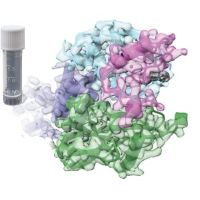Specification
| Description | Recombinant protein from the full-length sequence of Homo sapiens LYN proto-oncogene, Src family tyrosine kinase (LYN), transcript variant 2 (NM_001111097). |
| Organism | Homo sapiens (Human) |
| Expression Host | Human Cells |
| Tag Info | His or DYKDDDDK. Please contact us if you need further information or require specific designed tag. |
| Purity | Greater than 90% by SDS-PAGE gel |
| Uniprot ID | P07948 |
| Entry Name | LYN_HUMAN |
| Gene Names | LYN JTK8 |
| Alternative Gene Names | JTK8 |
| Alternative Protein Names | Tyrosine-protein kinase Lyn (EC 2.7.10.2) (Lck/Yes-related novel protein tyrosine kinase) (V-yes-1 Yamaguchi sarcoma viral related oncogene homolog) (p53Lyn) (p56Lyn) |
| Application | Antigens, Western, ELISA and other in vitro binding or in vivo functional assays, and protein-protein interaction studies; For research & development use only! |
| Buffer | Purified protein formulated in a sterile solution of PBS buffer, pH7.2, without any preservatives |
| Endotoxin | Endotoxin level is < 0.1 ng/µg of protein (<1EU /µg) |
| Length | 512 |
| Molecular Weight(Da) | 58574 |
| Protein Sequence | (The sequence of expressed protein may have some variation from the sequence shown below. Please contact us for the exact sequence.) MGCIKSKGKDSLSDDGVDLKTQPVRNTERTIYVRDPTSNKQQRPVPESQLLPGQRFQTKDPEEQGDIVVALYPYDGIHPDDLSFKKGEKMKVLEEHGEWWKAKSLLTKKEGFIPSNYVAKLNTLETEEWFFKDITRKDAERQLLAPGNSAGAFLIRESETLKGSFSLSVRDFDPVHGDVIKHYKIRSLDNGGYYISPRITFPCISDMIKHYQKQADGLCRRLEKACISPKPQKPWDKDAWEIPRESIKLVKRLGAGQFGEVWMGYYNNSTKVAVKTLKPGTMSVQAFLEEANLMKTLQHDKLVRLYAVVTREEPIYIITEYMAKGSLLDFLKSDEGGKVLLPKLIDFSAQIAEGMAYIERKNYIHRDLRAANVLVSESLMCKIADFGLARVIEDNEYTAREGAKFPIKWTAPEAINFGCFTIKSDVWSFGILLYEIVTYGKIPYPGRTNADVMTALSQGYRMPRVENCPDELYDIMKMCWKEKAEERPTFDYLQSVLDDFYTATEGQYQQQP |
Background
| Function | FUNCTION: Non-receptor tyrosine-protein kinase that transmits signals from cell surface receptors and plays an important role in the regulation of innate and adaptive immune responses, hematopoiesis, responses to growth factors and cytokines, integrin signaling, but also responses to DNA damage and genotoxic agents. Functions primarily as negative regulator, but can also function as activator, depending on the context. Required for the initiation of the B-cell response, but also for its down-regulation and termination. Plays an important role in the regulation of B-cell differentiation, proliferation, survival and apoptosis, and is important for immune self-tolerance. Acts downstream of several immune receptors, including the B-cell receptor, CD79A, CD79B, CD5, CD19, CD22, FCER1, FCGR2, FCGR1A, TLR2 and TLR4. Plays a role in the inflammatory response to bacterial lipopolysaccharide. Mediates the responses to cytokines and growth factors in hematopoietic progenitors, platelets, erythrocytes, and in mature myeloid cells, such as dendritic cells, neutrophils and eosinophils. Acts downstream of EPOR, KIT, MPL, the chemokine receptor CXCR4, as well as the receptors for IL3, IL5 and CSF2. Plays an important role in integrin signaling. Regulates cell proliferation, survival, differentiation, migration, adhesion, degranulation, and cytokine release. Down-regulates signaling pathways by phosphorylation of immunoreceptor tyrosine-based inhibitory motifs (ITIM), that then serve as binding sites for phosphatases, such as PTPN6/SHP-1, PTPN11/SHP-2 and INPP5D/SHIP-1, that modulate signaling by dephosphorylation of kinases and their substrates. Phosphorylates LIME1 in response to CD22 activation. Phosphorylates BTK, CBL, CD5, CD19, CD72, CD79A, CD79B, CSF2RB, DOK1, HCLS1, LILRB3/PIR-B, MS4A2/FCER1B, SYK and TEC. Promotes phosphorylation of SIRPA, PTPN6/SHP-1, PTPN11/SHP-2 and INPP5D/SHIP-1. Mediates phosphorylation of the BCR-ABL fusion protein. Required for rapid phosphorylation of FER in response to FCER1 activation. Mediates KIT phosphorylation. Acts as an effector of EPOR (erythropoietin receptor) in controlling KIT expression and may play a role in erythroid differentiation during the switch between proliferation and maturation. Depending on the context, activates or inhibits several signaling cascades. Regulates phosphatidylinositol 3-kinase activity and AKT1 activation. Regulates activation of the MAP kinase signaling cascade, including activation of MAP2K1/MEK1, MAPK1/ERK2, MAPK3/ERK1, MAPK8/JNK1 and MAPK9/JNK2. Mediates activation of STAT5A and/or STAT5B. Phosphorylates LPXN on 'Tyr-72'. Kinase activity facilitates TLR4-TLR6 heterodimerization and signal initiation. Phosphorylates SCIMP on 'Tyr-107'; this enhances binding of SCIMP to TLR4, promoting the phosphorylation of TLR4, and a selective cytokine response to lipopolysaccharide in macrophages (By similarity). Phosphorylates CLNK (By similarity). {ECO:0000250|UniProtKB:P25911, ECO:0000269|PubMed:10574931, ECO:0000269|PubMed:10748115, ECO:0000269|PubMed:10891478, ECO:0000269|PubMed:11435302, ECO:0000269|PubMed:11517336, ECO:0000269|PubMed:11825908, ECO:0000269|PubMed:14726379, ECO:0000269|PubMed:15795233, ECO:0000269|PubMed:16467205, ECO:0000269|PubMed:17640867, ECO:0000269|PubMed:17977829, ECO:0000269|PubMed:18056483, ECO:0000269|PubMed:18070987, ECO:0000269|PubMed:18235045, ECO:0000269|PubMed:18577747, ECO:0000269|PubMed:18802065, ECO:0000269|PubMed:19290919, ECO:0000269|PubMed:20037584, ECO:0000269|PubMed:7687428}. |
| Pathway | |
| Protein Families | Protein kinase superfamily, Tyr protein kinase family, SRC subfamily |
| Tissue Specificity | Detected in monocytes (at protein level). Detected in placenta, and in fetal brain, lung, liver and kidney. Widely expressed in a variety of organs, tissues, and cell types such as epidermoid, hematopoietic, and neuronal cells. Expressed in primary neuroblastoma tumors. {ECO:0000269|PubMed:3561390, ECO:0000269|PubMed:8064233}. |
QC Data
| Note | Please contact us for QC Data |
| Product Image (Reference Only) |  |

